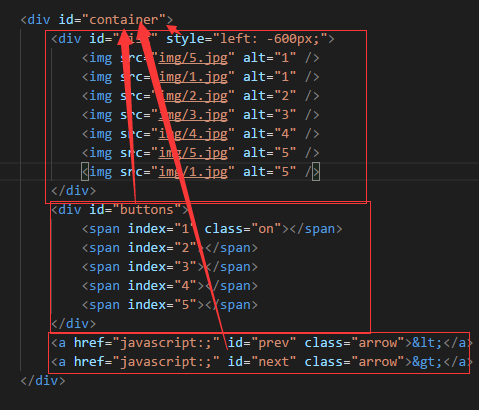lunbotu
HTML代码如下
<!DOCTYPE html>
<html>
<head>
<meta charset="UTF-8">
<title></title>
</head>
<body>
<div id="container">
<div id="list" style="left: -600px;">
<img src="img/5.jpg" alt="1" />
<img src="img/1.jpg" alt="1" />
<img src="img/2.jpg" alt="2" />
<img src="img/3.jpg" alt="3" />
<img src="img/4.jpg" alt="4" />
<img src="img/5.jpg" alt="5" />
<img src="img/1.jpg" alt="5" />
</div>
<div id="buttons">
<span index="1" class="on"></span>
<span index="2"></span>
<span index="3"></span>
<span index="4"></span>
<span index="5"></span>
</div>
<a href="javascript:;" id="prev" class="arrow"><</a>
<a href="javascript:;" id="next" class="arrow">></a>
</div>
</body>
</html>
疑问一:为什么用id?
方便获取被操作的元素
疑问二:为什么轮播图加类“on”?
为了方便操作,如果加了"on",即说明当前图片正在轮播
疑问三:
<a href="javascript:;" id="prev" class="arrow"><</a>
//href="javascript:;" 是为了防止多次点击,并且为了防止跳出链接
//id = prev 是为了获取操作
//class = arrow 是属于左右移动
//<是左括号 "<" ,属于web安全符号
疑问四:为什么加了一个单独的样式,style = left: -600px;
<div id="list" style="left: -600px;">
<img src="img/5.jpg" alt="1" />
<img src="img/1.jpg" alt="1" />
<img src="img/2.jpg" alt="2" />
<img src="img/3.jpg" alt="3" />
<img src="img/4.jpg" alt="4" />
<img src="img/5.jpg" alt="5" />
<img src="img/1.jpg" alt="5" />
</div>
为了实现轮播图偏移量。
CSS代码如下
* {
margin: 0;
padding: 0;
text-decoration: none;
}
body {
padding: 20px;
}
#container {
position: relative;
width: 600px;
height: 400px;
border: 3px solid #333;
overflow: hidden;
}
#list {
position: absolute;
z-index: 1;
width: 4200px;
height: 400px;
}
#list img {
float: left;
width: 600px;
height: 400px;
}
#buttons {
position: absolute;
left: 250px;
bottom: 20px;
z-index: 2;
height: 10px;
}
#buttons span {
float: left;
margin-right: 5px;
width: 10px;
height: 10px;
border: 1px solid #fff;
border-radius: 50%;
background: #333;
cursor: pointer;
}
#buttons .on {
background: orangered;
}
.arrow {
position: absolute;
top: 180px;
z-index: 2;
display: none;
width: 40px;
height: 40px;
font-size: 36px;
font-weight: bold;
line-height: 39px;
text-align: center;
color: #fff;
background-color: RGBA(0, 0, 0, .3);
cursor: pointer;
}
.arrow:hover {
background-color: RGBA(0, 0, 0, .7);
}
#container:hover .arrow {
display: block;
}
#prev {
left: 20px;
}
#next {
right: 20px;
}
疑问一:谈论一下绝对定位和相对定位?
position: relative 是相对定位
position: absolute是绝对定位
如果父元素没有被赋予相对定位,那么子元素的绝对定位是基于网页的!
疑问二:为什么用.7? 而不是0.7
.arrow:hover {
background-color: RGBA(0, 0, 0, .7);
}
为了方便书写,可以用.7替代0.7。
疑问三:父元素用相对定位,子元素为什么一定要用绝对定位?
父元素:
#container {
position: relative;
width: 600px;
height: 400px;
border: 3px solid #333;
overflow: hidden;
}
子元素:
#list {
position: absolute;
z-index: 1;
width: 4200px;
height: 400px;
}
如何区分父元素和子元素 , 即包括起来的,如下图所示

所有元素的父元素就是 container
所有绝对定位都是相对于父元素 container
JS代码如下
window.onload = function() {
var container = document.getElementById('container');
var list = document.getElementById('list');
var imgLen= document.getElementTagName('img');
var buttons = document.getElementById('buttons').getElementsByTagName('span');
var prev = document.getElementById('prev');
var next = document.getElementById('next');
var index = 1;
var timer;
function animate(offset) {
//获取的是style.left,是相对左边获取距离,所以第一张图后style.left都为负值,
//且style.left获取的是字符串,需要用parseInt()取整转化为数字。
var newLeft = parseInt(list.style.left) + offset;
list.style.left = newLeft + 'px';
//无限滚动判断
if (newLeft > -600) {
list.style.left = -3000 + 'px';
}
if (newLeft < -3000) {
list.style.left = -600 + 'px';
}
}
function play() {
//重复执行的定时器
timer = setInterval(function() {
next.onclick();
}, 2000)
}
function stop() {
clearInterval(timer);
}
function buttonsShow() {
//将之前的小圆点的样式清除
for (var i = 0; i < buttons.length; i++) {
if (buttons[i].className == "on") {
buttons[i].className = "";
}
}
//数组从0开始,故index需要-1
buttons[index - 1].className = "on";
}
prev.onclick = function() {
index -= 1;
if (index < 1) {
index = 5
}
buttonsShow();
animate(600);
};
next.onclick = function() {
//由于上边定时器的作用,index会一直递增下去,我们只有5个小圆点,所以需要做出判断
index += 1;
if (index > 5) {
index = 1
}
animate(-600);
buttonsShow();
};
for (var i = 0; i < buttons.length; i++) {
(function(i) {
buttons[i].onclick = function() {
/* 这里获得鼠标移动到小圆点的位置,用this把index绑定到对象buttons[i]上,去谷歌this的用法 */
/* 由于这里的index是自定义属性,需要用到getAttribute()这个DOM2级方法,去获取自定义index的属性*/
var clickIndex = parseInt(this.getAttribute('index'));
var offset = 600 * (index - clickIndex); //这个index是当前图片停留时的index
animate(offset);
index = clickIndex; //存放鼠标点击后的位置,用于小圆点的正常显示
buttonsShow();
}
})(i)
}
container.onmouseover = stop;
container.onmouseout = play;
play();
}




 浙公网安备 33010602011771号
浙公网安备 33010602011771号